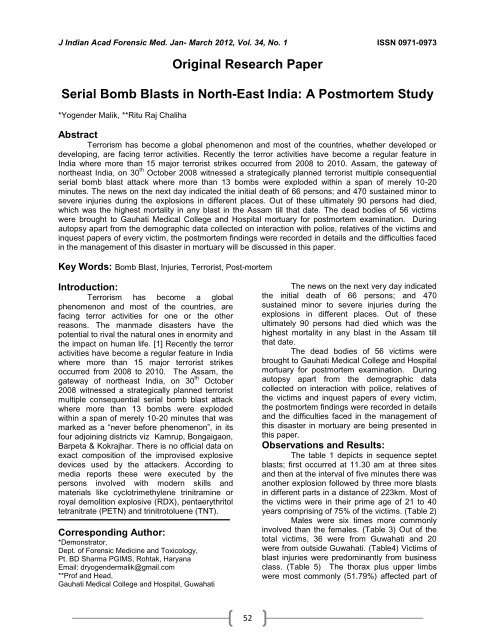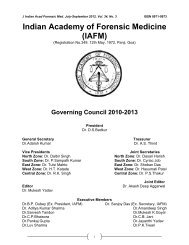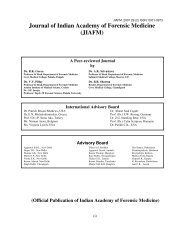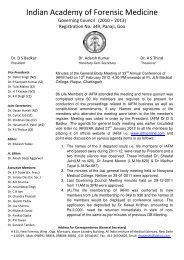Indian Academy of Forensic Medicine (IAFM) - Official website of IAFM
Indian Academy of Forensic Medicine (IAFM) - Official website of IAFM
Indian Academy of Forensic Medicine (IAFM) - Official website of IAFM
You also want an ePaper? Increase the reach of your titles
YUMPU automatically turns print PDFs into web optimized ePapers that Google loves.
J <strong>Indian</strong> Acad <strong>Forensic</strong> Med. Jan- March 2012, Vol. 34, No. 1 ISSN 0971-0973<br />
Original Research Paper<br />
Serial Bomb Blasts in North-East India: A Postmortem Study<br />
*Yogender Malik, **Ritu Raj Chaliha<br />
Abstract<br />
Terrorism has become a global phenomenon and most <strong>of</strong> the countries, whether developed or<br />
developing, are facing terror activities. Recently the terror activities have become a regular feature in<br />
India where more than 15 major terrorist strikes occurred from 2008 to 2010. Assam, the gateway <strong>of</strong><br />
northeast India, on 30 th October 2008 witnessed a strategically planned terrorist multiple consequential<br />
serial bomb blast attack where more than 13 bombs were exploded within a span <strong>of</strong> merely 10-20<br />
minutes. The news on the next day indicated the initial death <strong>of</strong> 66 persons; and 470 sustained minor to<br />
severe injuries during the explosions in different places. Out <strong>of</strong> these ultimately 90 persons had died,<br />
which was the highest mortality in any blast in the Assam till that date. The dead bodies <strong>of</strong> 56 victims<br />
were brought to Gauhati Medical College and Hospital mortuary for postmortem examination. During<br />
autopsy apart from the demographic data collected on interaction with police, relatives <strong>of</strong> the victims and<br />
inquest papers <strong>of</strong> every victim, the postmortem findings were recorded in details and the difficulties faced<br />
in the management <strong>of</strong> this disaster in mortuary will be discussed in this paper.<br />
Key Words: Bomb Blast, Injuries, Terrorist, Post-mortem<br />
Introduction:<br />
Terrorism has become a global<br />
phenomenon and most <strong>of</strong> the countries, are<br />
facing terror activities for one or the other<br />
reasons. The manmade disasters have the<br />
potential to rival the natural ones in enormity and<br />
the impact on human life. [1] Recently the terror<br />
activities have become a regular feature in India<br />
where more than 15 major terrorist strikes<br />
occurred from 2008 to 2010. The Assam, the<br />
gateway <strong>of</strong> northeast India, on 30 th October<br />
2008 witnessed a strategically planned terrorist<br />
multiple consequential serial bomb blast attack<br />
where more than 13 bombs were exploded<br />
within a span <strong>of</strong> merely 10-20 minutes that was<br />
marked as a “never before phenomenon”, in its<br />
four adjoining districts viz Kamrup, Bongaigaon,<br />
Barpeta & Kokrajhar. There is no <strong>of</strong>ficial data on<br />
exact composition <strong>of</strong> the improvised explosive<br />
devices used by the attackers. According to<br />
media reports these were executed by the<br />
persons involved with modern skills and<br />
materials like cyclotrimethylene trinitramine or<br />
royal demolition explosive (RDX), pentaerythritol<br />
tetranitrate (PETN) and trinitrotoluene (TNT).<br />
Corresponding Author:<br />
*Demonstrator,<br />
Dept. <strong>of</strong> <strong>Forensic</strong> <strong>Medicine</strong> and Toxicology,<br />
Pt. BD Sharma PGIMS, Rohtak, Haryana<br />
Email: dryogendermalik@gmail.com<br />
**Pr<strong>of</strong> and Head,<br />
Gauhati Medical College and Hospital, Guwahati<br />
52<br />
The news on the next very day indicated<br />
the initial death <strong>of</strong> 66 persons; and 470<br />
sustained minor to severe injuries during the<br />
explosions in different places. Out <strong>of</strong> these<br />
ultimately 90 persons had died which was the<br />
highest mortality in any blast in the Assam till<br />
that date.<br />
The dead bodies <strong>of</strong> 56 victims were<br />
brought to Gauhati Medical College and Hospital<br />
mortuary for postmortem examination. During<br />
autopsy apart from the demographic data<br />
collected on interaction with police, relatives <strong>of</strong><br />
the victims and inquest papers <strong>of</strong> every victim,<br />
the postmortem findings were recorded in details<br />
and the difficulties faced in the management <strong>of</strong><br />
this disaster in mortuary are being presented in<br />
this paper.<br />
Observations and Results:<br />
The table 1 depicts in sequence septet<br />
blasts; first occurred at 11.30 am at three sites<br />
and then at the interval <strong>of</strong> five minutes there was<br />
another explosion followed by three more blasts<br />
in different parts in a distance <strong>of</strong> 223km. Most <strong>of</strong><br />
the victims were in their prime age <strong>of</strong> 21 to 40<br />
years comprising <strong>of</strong> 75% <strong>of</strong> the victims. (Table 2)<br />
Males were six times more commonly<br />
involved than the females. (Table 3) Out <strong>of</strong> the<br />
total victims, 36 were from Guwahati and 20<br />
were from outside Guwahati. (Table4) Victims <strong>of</strong><br />
blast injuries were predominantly from business<br />
class. (Table 5) The thorax plus upper limbs<br />
were most commonly (51.79%) affected part <strong>of</strong>









